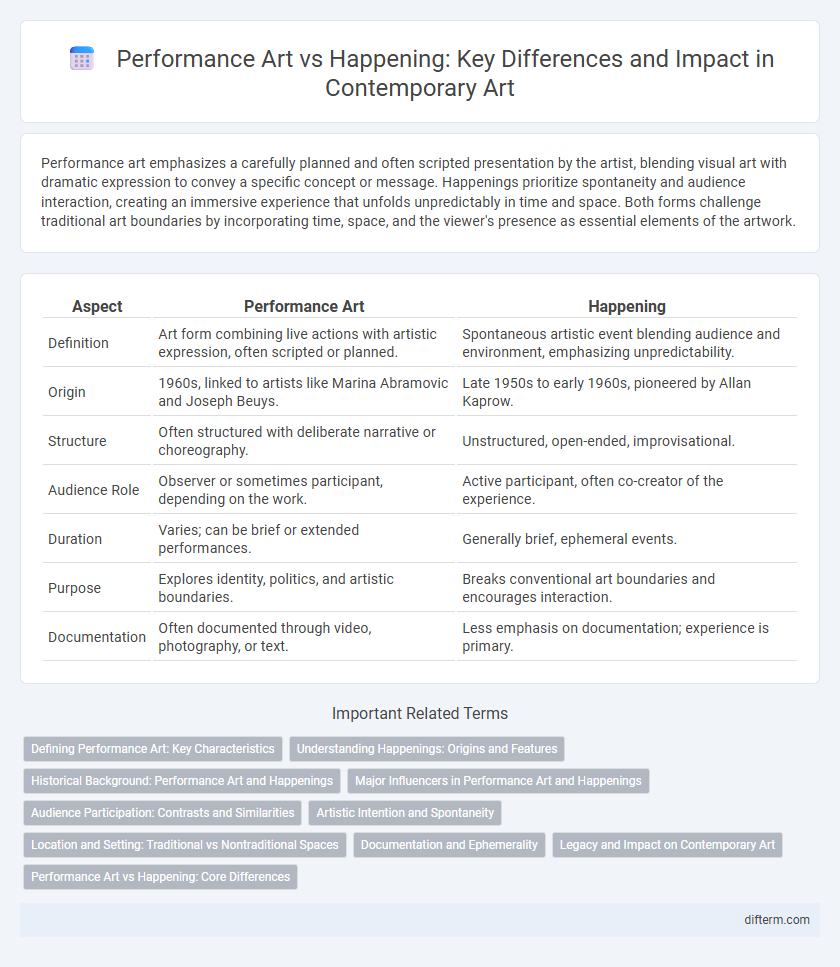Performance art emphasizes a carefully planned and often scripted presentation by the artist, blending visual art with dramatic expression to convey a specific concept or message. Happenings prioritize spontaneity and audience interaction, creating an immersive experience that unfolds unpredictably in time and space. Both forms challenge traditional art boundaries by incorporating time, space, and the viewer's presence as essential elements of the artwork.
Table of Comparison
| Aspect | Performance Art | Happening |
|---|---|---|
| Definition | Art form combining live actions with artistic expression, often scripted or planned. | Spontaneous artistic event blending audience and environment, emphasizing unpredictability. |
| Origin | 1960s, linked to artists like Marina Abramovic and Joseph Beuys. | Late 1950s to early 1960s, pioneered by Allan Kaprow. |
| Structure | Often structured with deliberate narrative or choreography. | Unstructured, open-ended, improvisational. |
| Audience Role | Observer or sometimes participant, depending on the work. | Active participant, often co-creator of the experience. |
| Duration | Varies; can be brief or extended performances. | Generally brief, ephemeral events. |
| Purpose | Explores identity, politics, and artistic boundaries. | Breaks conventional art boundaries and encourages interaction. |
| Documentation | Often documented through video, photography, or text. | Less emphasis on documentation; experience is primary. |
Defining Performance Art: Key Characteristics
Performance art is a live artistic expression that combines various disciplines such as theater, dance, music, and visual art, emphasizing the artist's presence and actions in real-time. Key characteristics include improvisation, audience interaction, and a focus on the ephemeral nature of the experience, differentiating it from scripted or rehearsed theater. Unlike happenings, performance art often conveys a conceptual message or critique, making the artist's intention central to the work's meaning.
Understanding Happenings: Origins and Features
Happenings emerged in the late 1950s as a form of performance art characterized by spontaneous, unscripted events that blurred the lines between artist and audience. Rooted in the avant-garde movement, key figures like Allan Kaprow defined Happenings as interactive experiences emphasizing chance, participation, and the ephemeral nature of art. Unlike traditional performance art, Happenings integrate environmental elements and unpredictability, fostering a dynamic space where meaning evolves through collective experience.
Historical Background: Performance Art and Happenings
Performance art emerged in the 1960s as a radical form emphasizing live, ephemeral experiences, often blending theater, visual art, and audience interaction. Happenings, originating in the late 1950s through artists like Allan Kaprow, were spontaneous, unscripted events designed to blur the boundaries between art and everyday life. Both movements sought to challenge traditional art forms, but performance art focused more on the artist's expressive presence while happenings relied heavily on audience participation and chance.
Major Influencers in Performance Art and Happenings
Major influencers in performance art include Marina Abramovic, whose endurance-based works challenge physical and mental limits, and Joseph Beuys, known for integrating social philosophy into art. In happenings, Allan Kaprow pioneered the genre by creating immersive, participatory events that blurred the line between art and life. Both movements share roots in the 1960s avant-garde culture, emphasizing audience interaction and spontaneity.
Audience Participation: Contrasts and Similarities
Performance art typically involves scripted or choreographed actions where audience participation is often limited to observation or minimal interaction, emphasizing the artist's expression. Happening blurs the line between artist and audience by encouraging spontaneous, active participation, transforming viewers into co-creators within an unpredictable event. Both forms challenge traditional art boundaries but differ significantly in the degree and nature of audience involvement.
Artistic Intention and Spontaneity
Performance art emphasizes a deliberate artistic intention, where the artist carefully plans and constructs the narrative or concept to convey a specific message or emotion. In contrast, happenings prioritize spontaneity and audience interaction, often embracing unpredictability and improvisation as core elements of the experience. Both forms challenge traditional art boundaries but differ fundamentally in the balance between premeditated structure and impulsive creation.
Location and Setting: Traditional vs Nontraditional Spaces
Performance art often occurs in traditional venues like theaters or galleries, emphasizing controlled environments designed for audience engagement and acoustics. Happenings break from these conventions by taking place in nontraditional spaces such as streets, parks, or abandoned buildings, integrating the environment directly into the experience. The choice of location fundamentally shapes the interaction between the artwork, the audience, and the surrounding context, challenging conventional boundaries of art presentation.
Documentation and Ephemerality
Performance art emphasizes the living, temporal experience where documentation serves primarily as a secondary record, often failing to capture the full essence of the artist's intent. Happenings, inherently spontaneous and audience-driven, embody ephemerality with minimal documentation, highlighting the moment's transience and challenging conventional archival practices. The tension between preservation and impermanence defines how each form negotiates its legacy within contemporary art discourse.
Legacy and Impact on Contemporary Art
Performance art revolutionized artistic expression by emphasizing the artist's presence and ephemeral actions, profoundly influencing contemporary art's embrace of experiential and interactive practices. Happenings blurred the lines between art and life, fostering participatory environments that challenged traditional spectatorship and laid groundwork for immersive installations. Both forms contributed to the dissolution of conventional art boundaries, embedding concepts of temporality, audience engagement, and unpredictability into modern art discourses.
Performance Art vs Happening: Core Differences
Performance art emphasizes the artist's deliberate, often scripted actions as a medium, creating a defined narrative or concept within a controlled setting. Happening, pioneered by Allan Kaprow in the 1950s, involves spontaneous, participatory events that blur the line between artist and audience, emphasizing unpredictability and environmental interaction. The core difference lies in performance art's structured expression versus happening's open-ended, immersive experience.
performance art vs happening Infographic

 difterm.com
difterm.com